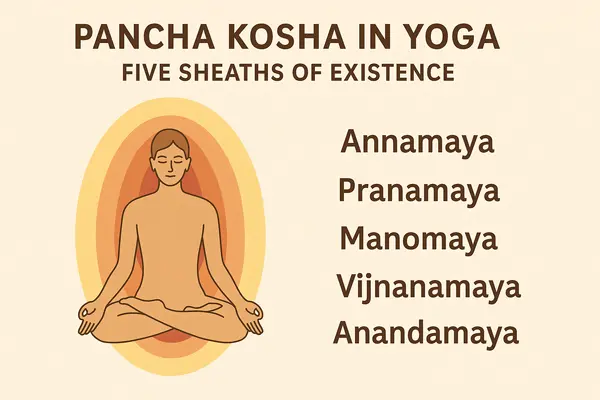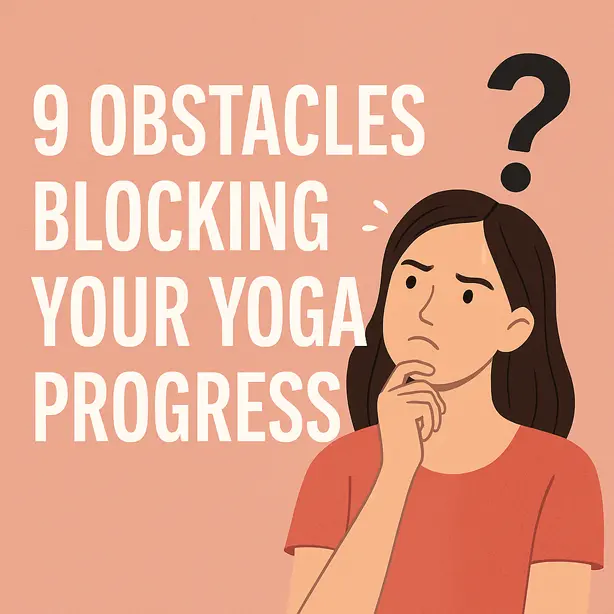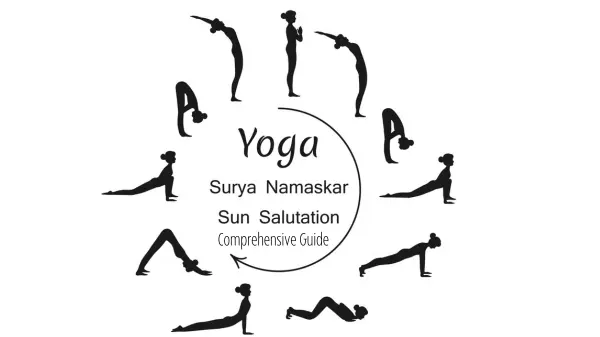Panchkoshas are the five sheaths of the body. Pancha refers to the five, and koshas refers to the sheaths or layers.
To comprehend this, we can take the example of Matryoshka dolls, Russian or stacking dolls. One doll is placed into another (smaller to larger).

The five sheaths or layers are in the personality of our existence, of our being, moving from the gross to the subtle or body to the bliss.
The Taittiriya Upanishad (Yajur Veda) mentions the human body with five sheaths.[1] It states that our personality has five layers, and we move from gross to subtle. A person is a multi-layered being.
Pancha Koshas Briefly
1. Annamaya Kosha (Physical Sheath)
2. Pranamaya Kosha (Energy Sheath)
3. Manomaya Kosha (Emotional Sheath)
4. Vijanamaya Kosha (Wisdom Sheath)
5. Anandamaya Kosha (Bliss Sheath)
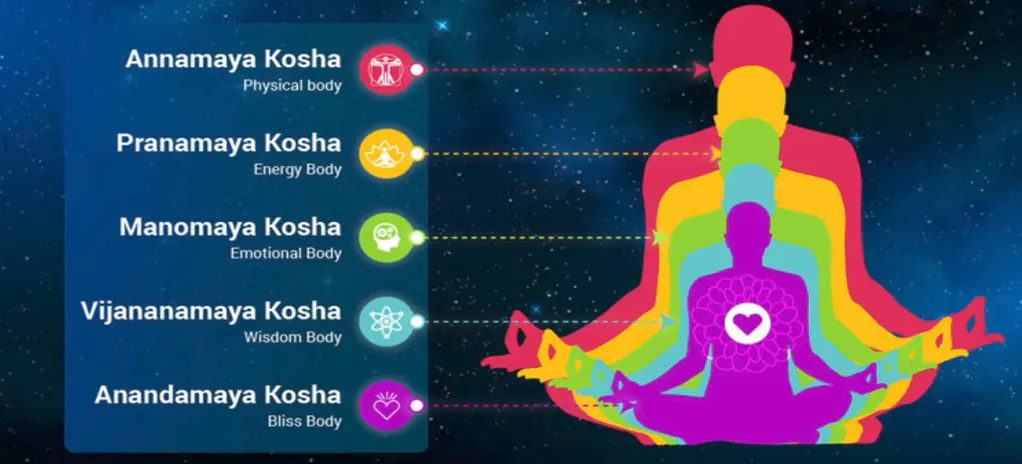
1. Annamaya Kosha (Physical Sheath)
- This is the outermost layer of all the koshas.
- It is the food sheath. Anna means food in Sanskrit.
- It is a physical form sustained by the food intake.
- It includes the five organs of perception and the five organs of action.
- It has a super slow vibrational frequency.
- This layer, the sheath or body, can’t exist without being in contact with other koshas or sheaths.
- A particular memory shapes this body in one specific way, such as the DNA of your ancestors.
- It is made up of 5 elements and is perishable.
- It has birth and death, or the beginning and the end, which is unavoidable.
- This sheath perfectly depicts the duality of nature.
2. Pranamaya Kosha (Energy Sheath)
- The vital sheath. Prana means the life force or vital air.
- Breath is the gross form of Prana, or, in other words, the physical manifestation of Prana is breath.
- The pranas flow through our nadis.
- Nadis are energy channels. These are not ordinary nerves, veins, or arteries. Nadis are beyond physical concept and can’t be seen by the naked eye.
- Pranamaya kosha includes breath and the 5 Vayus: Prana, Apana, Samana, Udana, and Vyana.
- It is responsible for the blood flow in the body.
- It carries the impulses through the nerves, through your body, to your brain, and back.
- Pranamaya kosha allows us to travel from the gross to the subtle or causal body.
- You can nourish this sheath through food, sunlight, practising pranayama or asanas, and meditation.
- A person cannot simply have a living out of a physical existence. There has to be a force that keeps it going.[2]
3. Manomaya Kosha (Emotional Sheath)
- The mental sheath is called “Manomaya Kosha.” “Mano” is mind. The mental sheath is nourished by knowledge.
- It consists of our thoughts, feelings, emotions, and minds.
- To transcend from this kosha, one has to withdraw from the senses. One has to practice Pranayama and Asanas for that.
If we take a modern example, Annamaya Kosha is the hardware. Pranamaya Kosha is the quality power that connects hardware to software. Manomaya Kosha is the software.
4. Vijanamaya Kosha (Wisdom Sheath)
- The wisdom sheath is called “Vijanamaya Kosha.” “Vijana” means intellect, and “Jnana” means knowledge in Sanskrit. Intellect is known as Buddhi in Sanskrit.
- When you make choices like “I like this,” “I don’t like this,” or “I want to have this,” you are using your intellect.
- Vijanamaya Kosha links the Universal mind with the individual mind. In other words, Super-consciousness with the individual consciousness.
- Universal knowledge comes to the conscious mind through the Vijanamaya Kosha.
- The mind sees an object’s outlook, but Vijanamaya Kosha sees the object as part of the universe.
- You can work on this sheath with meditation, selfless service, self-inquiry, reading yogic philosophy and implementing it.
5. Anandamaya Kosha (Bliss Sheath)
- The bliss sheath. Ananda means bliss in Sanskrit.
- Our spiritual or causal body is where we finally become one with the divine.
- It is the highest possible vibration of human life.
- Liberation or mukti is Anandamaya Kosha.
The relation between the Pancha Koshas and the three bodies
In Yoga, there are more bodies than the physical body. The physical or Gross body is the first, and the subtle and causal bodies are second and third, respectively.
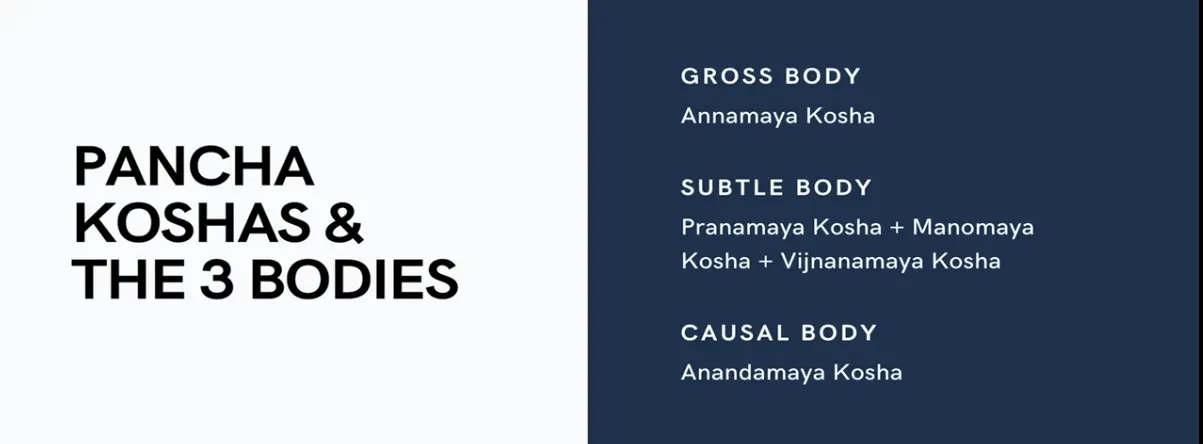
1. The Gross body is made up of Annamaya Kosha
2. The subtle body comprises Pranamaya, Manomaya, and Vijanamaya Kosha.
3. The causal body is made up of Anandmaya Kosha
Modern Example of Panch Koshas
We can also understand the concept of the 5 sheaths by equating them with the types of internet connections.
1. Annamaya Kosha (Without any connection)
2. Pranamaya Kosha (Dial-up connection)
3. Manomaya Kosha (Broadband connection)
4. Vijanamaya Kosha (Wifi connection)
5. Anandamaya Kosha (Satellite connection or non-stop connection)
As we move towards the Anadmaya kosha, the connection becomes faster. The connection with the self or the supreme, or the ultimate.
How to transcend Panch Kosha
The question that arises here is, what’s the need to transcend the panch kosha?
Your true self or the ultimate truth is beyond the panch kosha, or the five layers. The goal of human life is to eventually find the ultimate truth.
Each layer can be transcended through the yogic practices. As you work through these 5 layers, you will stop identifying with these layers. You will go beyond the body, mind, and intellect.
Conclusion
Panch koshas is the road map that ancient seers have left us to help us understand our journey back to wholeness, so that we can break free from all bondages. It will help you understand who you are; with this knowledge, you will transcend the grosser layers of your being.
Finally, psychological well-being with a blissful state of mind, soul and sense organs is an essential component of health.[3]
Reference
[1] Shukla M, Nathani N, Mishra PK, Kumar A. Neuroscience and the Pancha Kosha: A Scientific Exploration. Afr J Biomed Res. 2025;28(3S). Available from: Link to Study. <Go to Citation>
[2] Rayabagi P, Bhuvaneshwari. Contemplating the relevance of theory of Pancha Kosha in the present era. J Ayurveda Holist Med. 2023;11(2):72-77. Available from: Link to Study. <Go to Citation>
[3] Paijwar P, Awasthi HH, Mishra D. The Concept of Panchakosha: A Scientific Approach. Int J Indian Psychol. 2022;10(2):34-41. Available from: Link to Study. <Go to Citation>

